With ChatGPT, anyone can create blog posts in seconds. But, just because you have copy doesn’t mean it's valuable. You need content research to make a post that’s actually valuable. That’s especially true with Google’s Helpful Content Update, a shift that placed even more emphasis on expertise, knowledge, and credibility.
To stand out in today’s crowded landscape, teams need to craft content that’s not easily found elsewhere. Every paragraph needs to be rooted in deep research, diverse sources, and genuine insight that delivers meaningful value to the audience.
In this article, I'll give a guide on content research by going through a detailed report I published. Let’s get started.
Table of Contents
- What is content research?
- Why is content research important?
- How to Do Content Research
- Valuable Tips on Doing Content Research
Content research involves understanding your target audience’s needs, pain points, and search behaviors. It means digging into relevant data, reviewing credible sources, identifying gaps in existing content, and spotting emerging trends in your industry.
Done well, it involves a combination of:
- Keyword and SEO analysis.
- Competitor content reviews.
- Industry publications, academic studies, and expert interviews.
- Audience insights from social media, forums, or direct feedback.
- Strategic alignment with brand messaging and business objectives.
Given the massive amount of AI-generated content out there, solid content research helps me create impactful, trustworthy content that rises above the noise.
Why is content research important?
In the AI age, more and more people are starting their research on ChatGPT. When your potential customers have a question, they’ll likely ask AI first. And, if their query is informational, they’ll likely get a tailored answer and move on.
So, creating generic, informational content isn’t a sustainable strategy.
Instead, you need to dive deep into content research to come up with a unique angle. Thoughtful, in-depth research lays the foundation for content that is compelling, engaging, and genuinely helpful to users. Bonus points if you can run your own surveys and gather original data.
Content marketing is about positioning your brand as the go-to authority in your space. So, when someone asks a question to an AI tool, it cites your website as the source. That’s all because your content is rich, relevant, and trustworthy.
How to Do Content Research
To explain my content research process, I’ll describe the method I used to create this report on the ecommerce landscape in Pakistan.
This piece is heavily data-centric. It demanded deep, focused research across multiple sources to ensure accuracy, originality, and value. The entire process, from the initial stages of investigation to the final content publication, spanned three months.
Here’s how I approached content research, including clear, bite-sized steps that are easy to understand and apply.
Start with competitor research.
Typically, I start by reviewing what competitors have already published. This helps me understand the landscape and identify gaps. In the case of my report, we were breaking new ground. There were no existing content pieces to benchmark against, which meant we had to build everything from scratch.
While this presented a challenge, it also came with a big advantage: Being the first to publish a data-driven report positioned the brand as a thought leader.
When audiences see original insights backed by research, they’re more likely to view your brand as a credible authority in the space. That kind of trust is hard to beat.
Then, use tools to gather data.
My go-to tools for collecting data are Semrush and Ahrefs. Both platforms allow me to compare two websites side by side.
This becomes especially powerful when you're analyzing a top-ranking competitor against one that ranks slightly lower, revealing key differences in content, keywords, or backlinks. What gives the top performer its edge? These tools uncover exactly that.
For this report, I analyzed the traffic of the top five ecommerce stores. The aim was to rank the country’s leading ecommerce players and categorize them by whether they’re digitally native or focus on an offline presence.
For example, I used Semrush to get traffic data on the biggest ecommerce platforms. The traffic data was then provided in an easy-to-read table.
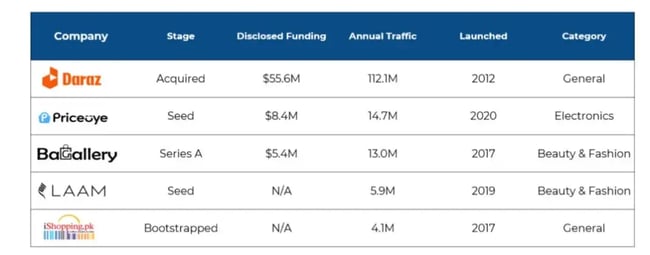
The chart clearly shows which ecommerce company has the most traffic and the highest estimated global revenue.
When conducting research, I recommend going the extra mile to provide added value for your readers. For instance, to offer better context and enable a more meaningful comparison, I included a brief analysis of trends in other emerging markets — such as the Philippines, Egypt, Indonesia, and Bangladesh.
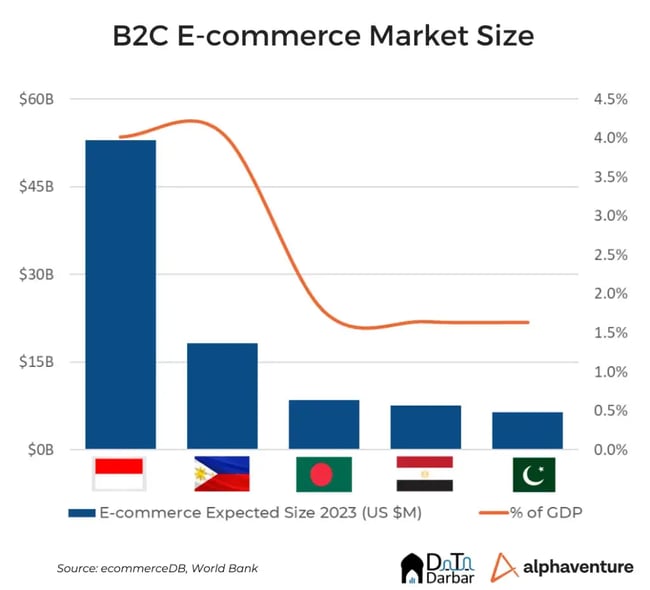
The idea of adding this additional layer of insight was to help readers better understand the bigger picture. To make this happen, I needed to have access to third-party sources (ECDB and World Bank, in my case).
If you aim to produce valuable, data-centric content on a regular basis, I recommend getting a subscription to Statista. It’s a treasure trove of studies that are directly relevant to your topic.
Keep in mind that not everyone has the time to sift through all the information and data you share. That’s why I included a concise TL;DR section highlighting the key takeaways and most important data points.
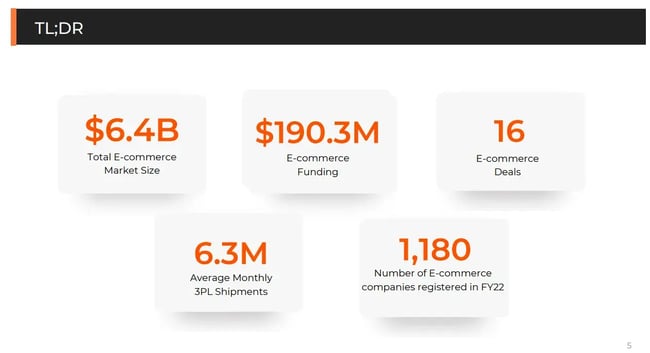
I provided this clear, data-backed starting point because I know this information will be valuable for anyone looking to start a new ecommerce business. The key takeaway here is to highlight the core insights from your content research to make it easy for readers to absorb.
For a deeper dive into market research, including a how-to guide, check out this market research guide and template.
Establish authority by answering questions.
To truly establish authority, focus on answering questions that others have overlooked or failed to address in depth. By tackling these underexplored topics with clarity and substance, you position yourself as a go-to expert in your field.
For this report, I took that extra step. I connected with Daraz, the largest ecommerce marketplace in the country, which provided my team with internal data that wouldn’t have been available through traditional online research.
Daraz provided a wealth of valuable insights covering sales performance, transaction volumes, and activity during peak months. The dataset was so rich that I could easily create at least five distinct content pieces. But, I managed to condense the research into a page that offered users real, actionable information backed by solid data.
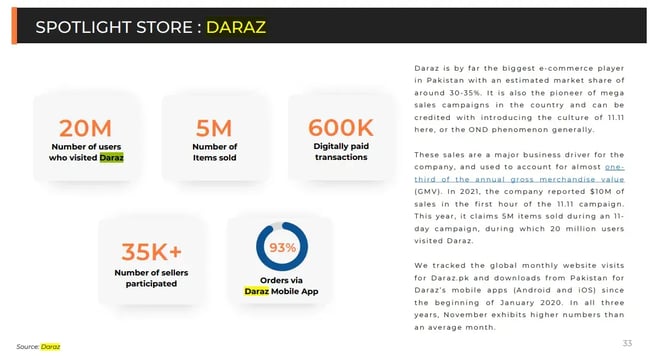
Doing content research on a deeper level helps surface new trends. After getting the data, I had numbers to show that November and the last quarter generally had higher sales. This level of information added real depth and credibility to the research.
Consult the experts for more insight.
In my opinion, content research goes far beyond simply gathering information from publicly available sources. In many cases, valuable data from industry leaders is needed, but it isn’t usually accessible online. That calls for reaching out to real people.
In the research phase, the more people you reach out to, the better. During our outreach, I connected with PostEx, a leading logistics company in the country with an estimated 1.45 million shipments per month.
Their team told us how the last quarter compared to the rest of the year in terms of total orders and order value. That kind of insight can only come from industry experts. It won’t appear in a Google search, and AI tools would just fabricate the data.
What began as a simple information request turned into something bigger: PostEx generously offered to sponsor the project — something we hadn’t initially planned for. Their involvement added both credibility and meaningful support to our research.
Reach out to people internally.
A component of content research is also gathering insights from people on your team.
For my report, I gained valuable high-level insights by having a 15-minute meeting with my CEO. He had built a price comparison engine earlier as a hobby project, which provided me with valuable information into the country's ecommerce landscape.
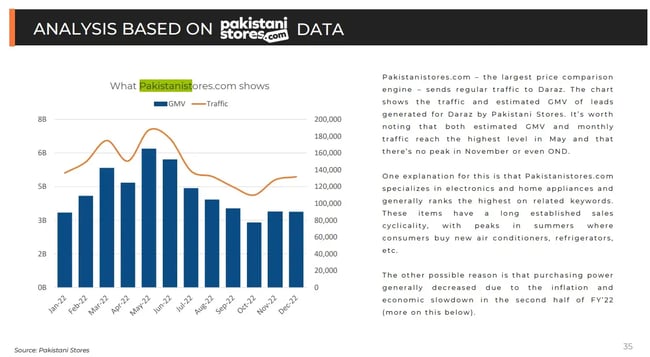
By tapping into that expertise, I was able to analyze the monthly traffic and GMV of Pakistan’s ecommerce marketplace.
Remember, internal knowledge-sharing can be powerful. Your colleagues might be experts themselves, or they might connect you to someone in their network who is.
Present the content research.
When you have done solid research, creating content becomes much easier. I believe the key is to strike a balance between written content and visuals. Since many people prefer to absorb information visually, I made sure the content included plenty of charts and graphics to enhance clarity and engagement.
Here’s an example of one of the graphics:
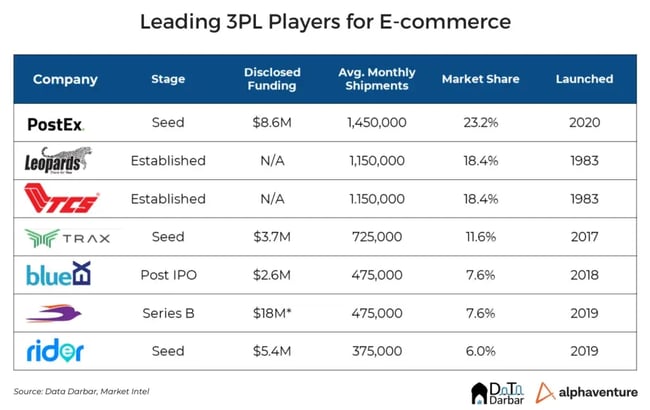
Some people prefer reading to fully grasp the details, so the report includes clear, well-written explanations, ensuring there’s something for everyone. These graphics also help in repurposing the content across email and social media, which brings me to my next point.
Further your business goals with content research.
Repurpose key findings into social posts and email campaigns. That can help you extend the life and reach of the research far beyond the original published piece.
After completing our content research, we decided to make the content gated. Users were required to sign up to access it. Because the content offered valuable insights, people were willing to fill out a form that included their company details and responses to tailored questions. So, we were able to dive warm leads for our company.
Be sure to align content research with strategic business objectives to drive measurable results across marketing and sales.
Valuable Tips on Doing Content Research
“People Also Ask” on Google
Beyond the standard search results, I always use the “People Also Ask” section on Google. Scrolling down to this area can reveal a wealth of related questions. I use it for additional topics to explore and gaps to fill in my content research.
There will be times when I need to create content on a topic I’m not yet an expert in. In this case it pays off to know the following tip on how to become equipped with relevant information quickly.
Type the keyword you are looking to research on Google. Let’s say I am writing about how AI is being used in the healthcare sector. Now, I don’t have a degree or a whole lot of expertise to write on this topic, but I can quickly learn what is happening in this field by learning from those who do have the expertise.
Here’s the formula that I use to type in search engines: Keyword + “expert opinion” + platform
Content Research on LinkedIn
A quick search can reveal what leading voices in the field are saying on LinkedIn. By finding and reading expert commentary, I can build a solid understanding of the subject and back my writing with insights from credible sources.

Remember to always do your due diligence. Take a moment to review their LinkedIn profiles or professional background to ensure their expertise is credible and relevant.
If you have a sizable following or a strong network in your industry, letting others know that you’re working on a piece can surface some experts you may already know. Your network might also have suggestions for other people or resources.
Content Research on Reddit
Reddit is a goldmine for research. Unlike LinkedIn, individual users remain anonymous and aren’t easily citable. But, the platform still offers valuable insights into public opinion and trending perspectives, helping you understand the general feeling surrounding a subject.

The goal of searching on these platforms is to analyze search intent. I want to know my users’ initial questions and their follow-ups. And in the process, I can uncover additional questions they may be searching for but haven’t yet articulated.
Other Platforms for Content Research
I find it valuable to uncover insightful background material on Quora and Substack. Searching Google Scholar for specific keywords and restricting results to anything from 2023 or later helps me locate experts and find the newest research.
These spaces offer direct access to perspectives from people deeply involved in the field.
Pro tip: Always check the publication date or filter your search to the past few years to ensure the information is still relevant. When reviewing studies, pay close attention to the sample size and geographic scope to properly assess the reliability and applicability of the findings.
The Role of E-E-A-T
With E-E-A-T (Experience, Expertise, Authoritativeness, and Trustworthiness) playing a crucial role, I know that my personal insights and the lessons I've learned over the years are incredibly valuable. So, don’t overlook your own experience. Start thinking about what you bring to the table in terms of your own experience, knowledge, and network.
Content Research Using Clearscope
Let’s say I am writing an article on “B2B Market Research,” so my first step is to type the keyword into Clearscope:
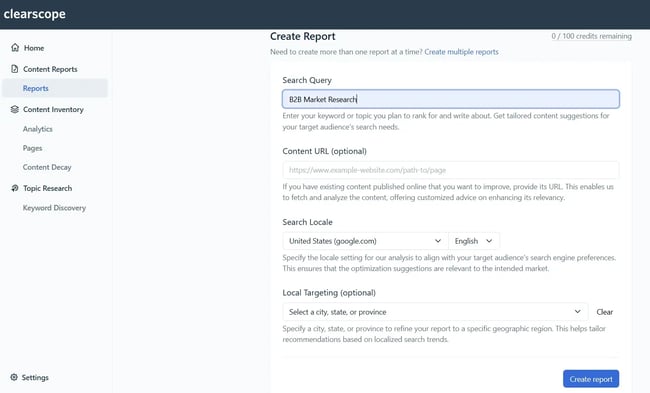
When I hit “Create report,” I can see the following interface with the “Terms,” “Research,” and “Outline” tabs on the right.
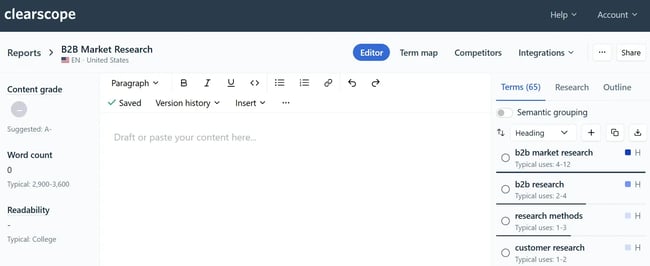
I use “Terms” to identify the key headings I need to research before I begin structuring the content. When I click on “Research,” it reveals the essential questions I should address to ensure the topic is covered thoroughly and comprehensively.

When I click on “Outline,” it pulls in the top-performing results from the SERPs (essentially showcasing my competitors). It even breaks down their heading structures, giving me a clear view of how they’ve organized their content.
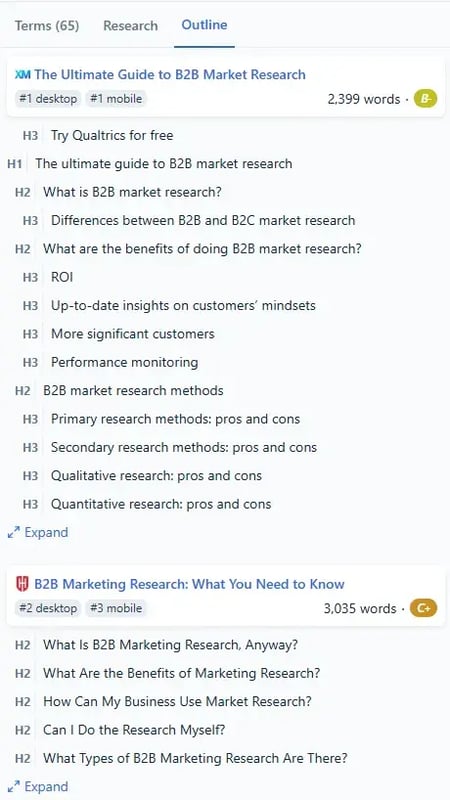
Notice how I can also see the word count for each of the top-performing articles. All this information helps me identify opportunities to improve upon their approach and create something even more holistic and valuable.
Pro tip: I think it can be very easy to inadvertently plagiarize from a competitor — maybe a definition, the structure of the post, or even a turn of phrase. To avoid this, I don’t spend a ton of time reading content from the competition. I really just skim the pages while researching.
Sending Out Surveys
I find that I attain valuable insights by sharing a survey directly with specific groups or communities. If I want to crowdsource insights without requiring respondents to reveal their identities, I use Typeform. It makes it simple for people to share candid, experience-based input.
This is especially helpful when I'm exploring sensitive topics or trying to understand real-world challenges my audience might not publicly discuss.
Confidently conduct content research.
When AI can generate content faster than ever, what truly sets valuable content apart is the combination of solid data and your unique perspective. That’s where human contribution becomes essential in content research.
To truly add value for readers across any industry, dig deeper to uncover unique insights and access information that isn’t readily available or widely known. Perform content research in such a way that users appreciate the depth of your content.
There are many ways to approach content research, and not every tip I’ve shared above may be relevant to your situation. After all, research is all about getting an outside perspective on a topic so that you get ideas and creative inspiration to frame the topic on your own.
Editor's note: This post was originally published in January 2025 and has been updated for comprehensiveness.




